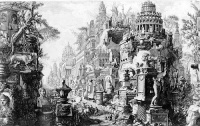Fantastic
From The Art and Popular Culture Encyclopedia
| Revision as of 21:33, 18 November 2012 Jahsonic (Talk | contribs) ← Previous diff |
Revision as of 21:34, 18 November 2012 Jahsonic (Talk | contribs) Next diff → |
||
| Line 6: | Line 6: | ||
| ==Fantastic literature== | ==Fantastic literature== | ||
| :''[[fantastic literature]]'' | :''[[fantastic literature]]'' | ||
| + | |||
| + | '''Fantastic literature''', '''fantastic fiction''' or '''fantastic tales''' is a [[literary genre]]. A great deal of literature, from every part of the world and dating back to time immemorial, falls within the category of ''[[fantastic]]''. Fairy tales like ''[[The Book of One Thousand and One Nights]]'' and epic literature like the ''[[Romance of the Holy Grail]]'' are within the [[scope]] of this genre. | ||
| + | |||
| + | '''Fantastic''' as a literary term was originated in the structuralist theory of critic [[Tzvetan Todorov]] in his 1970 treatise ''[[The Fantastic: A Structural Approach to a Literary Genre]]''. Todorov describes the fantastic as being a [[liminal]] state of the [[supernatural]]. A truly fantastic work is subtle in the working of the feeling, and would leave the reader with a sense of [[confusion]] about the work, and whether or not the phenomenon was real or imagined. [[Tzvetan Todorov]] holds that [[fantastic literature]] involves an [[unresolved]] [[hesitation]] between a [[supernatural]] (or otherwise paranormal or impossible) solution and a psychological (or realistic) one. His term ''hesitation'' is reminiscent of the terms ''[[ambiguity]]'' and ''[[ambivalence]]'' used in the definition of the [[Grotesque sensibility in literature|grotesque]]. | ||
| + | |||
| + | Todorov compares the fantastic with two other ideas: The [[Uncanny]], wherein the phenomenon turns out to have a rational explanation such as in the [[Gothic fiction|gothic]] works of [[Ann Radcliffe]]; or the [[marvelous]], where there truly is a supernatural explanation for the phenomenon. | ||
| + | |||
| ==Fantastic art== | ==Fantastic art== | ||
| :''[[fantastic art]]'' | :''[[fantastic art]]'' | ||
Revision as of 21:34, 18 November 2012
|
Related e |
|
Featured: |
The fantastic is a term in narratology and the visual arts. The term is derived from Latin phantasticus.
Contents |
Fantastic literature
Fantastic literature, fantastic fiction or fantastic tales is a literary genre. A great deal of literature, from every part of the world and dating back to time immemorial, falls within the category of fantastic. Fairy tales like The Book of One Thousand and One Nights and epic literature like the Romance of the Holy Grail are within the scope of this genre.
Fantastic as a literary term was originated in the structuralist theory of critic Tzvetan Todorov in his 1970 treatise The Fantastic: A Structural Approach to a Literary Genre. Todorov describes the fantastic as being a liminal state of the supernatural. A truly fantastic work is subtle in the working of the feeling, and would leave the reader with a sense of confusion about the work, and whether or not the phenomenon was real or imagined. Tzvetan Todorov holds that fantastic literature involves an unresolved hesitation between a supernatural (or otherwise paranormal or impossible) solution and a psychological (or realistic) one. His term hesitation is reminiscent of the terms ambiguity and ambivalence used in the definition of the grotesque.
Todorov compares the fantastic with two other ideas: The Uncanny, wherein the phenomenon turns out to have a rational explanation such as in the gothic works of Ann Radcliffe; or the marvelous, where there truly is a supernatural explanation for the phenomenon.
Fantastic art
Fantastique
Chronological bibliography of the fantastic in literature and art
- Das Unheimliche (1919) / The Uncanny - Sigmund Freud
- La carne, la morte, e il diavolo nella letteratura romantica (Italy, 1930) / Romantic Agony - Mario Praz
- Le Moyen Age fantastique (Paris, 1955) Jurgis Baltrusaitis
- The Grotesque in Art and Literature (1957) - Wolfgang Kayser
- Arts fantastiques (Paris, 1960) - Claude Roy
- L'Art et la littérature fantastiques (1960) - Louis Vax
- L'Art fantastique (1961) - Marcel Brion
- Au coeur du fantastique (Paris, 1965) - Roger Caillois
- Dreamers of Decadence: Symbolist Painters of the 1890s (1969) - Philippe Jullian
- Introduction à la littérature fantastique (1970) / The Fantastic: A Structural Approach to a Literary Genre - Tzvetan Todorov
- 200 Jahre Phantastische Malerei (Berlin, 1973) - Wieland Schmied
- Zauber Der Medusa: Europaische Manierismen (1987) by Werner Hofmann
- The Occult in Art (1990) - Owen S. Rachleff
- Les peintres du fantastique (1996) - André Barret
Notes: nature and scope of the fantastic as genre
On a semantic level, the term fantastic is ambiguous because it can mean greatness as well as a certain sensibility in the arts, where it is used to denote works which defy natural laws and traditional ideas of reality. In the visual arts this sensibility has been always important but it came especially to the fore in Mannerism, Romanticism, Symbolism, the Decadent movement and Surrealism.
The irony is of course that since some time, the word fantastique has been introduced in the English language. The benefit of the term fantastique is that it does not have the connotation of greatness which is linked with the word fantastic. Another irony is that the Germans have started using the term fantastik. In short, the fantastic as genre is the most complex area of research in genre theory, because of its universal presence and multi-language confusion.
Our ultimate aim is to reconcile the concepts of the uncanny, Das Unheimliche and the fantastic.
See also



